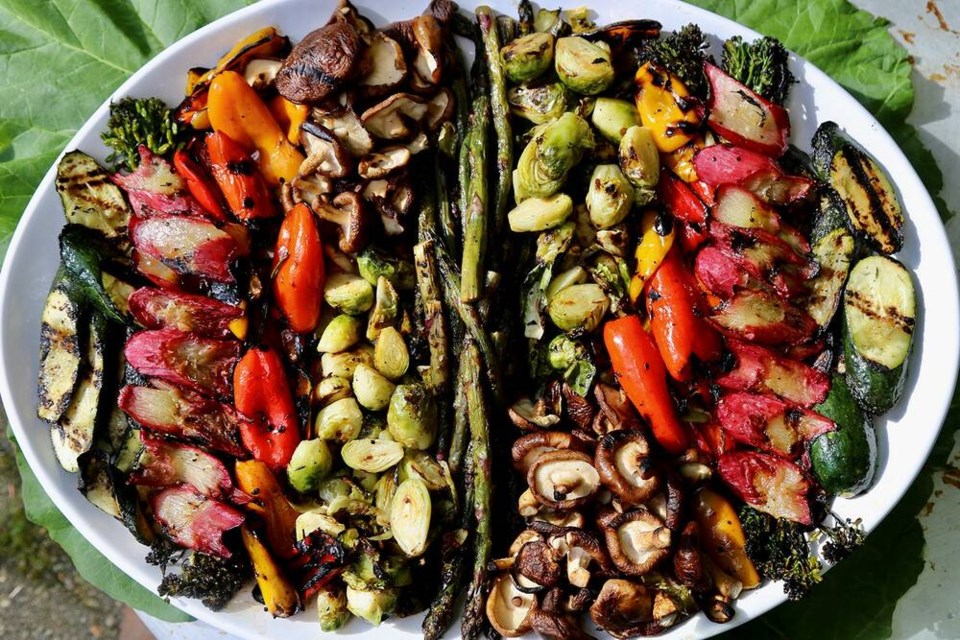Rhubarb, the extremely sour old fashioned “fruit” that appears early in spring, is actually more at home on a veggie plate than it is in a pie.
Rhubarb hails from Mongolia, according to botanists, but is well suited to Canada, where winter temperatures drop inhospitably low. Botanically speaking, rhubarb is a vegetable, not a fruit, as it has come to be known – perhaps for its propensity for residing in sugary desserts like crumbles, cobblers and pie.
Like celery, the part of a rhubarb plant that we eat are its petioles, or stalks. The huge elephant ear-like leaves are rarely eaten due to comparatively high levels of oxalic acid and other potential toxins. During the First World War, many Europeans were ill-advised to eat rhubarb leaves as a vegetable to ward off starvation, resulting sadly, in several reported cases of poisoning and even death due to kidney failure.
Spinach, beets, soy, almonds, raspberries, dates and some beans contain oxalates as well, however, so I am loath to panic. A balanced diet, rich in a delicious assortment of colourful organic vegetable seems to me, the bet hedge against oxalate build-up from over-indulgence.
I am drawn to bitter and sour vegetables and fruits in general, among the highest ironically, in complex phyto-nutrients. In our home, platters overflowing with spring and summer grilled vegetables and stone fruits, are among the best-loved of all menu items.
Gorgeous purple and green asparagus, shiitake and maitake mushrooms, cruciferous broccolini, rabe and brussels sprouts, sweet peppers and zucchini, and beautiful bright pink rhubarb paint every colour in the prescriptive culinary rainbow, and provide thousands of phytochemicals as well as antioxidant, anti-inflammatory nutrients.
Rhubarb alone, is an excellent source of dietary fibre pulling calcium, copper, iron, magnesium, manganese, phosphorus, potassium, sodium, selenium and zinc, along with vitamins B6, B12, K1, ascorbic acid, thiamin, riboflavin, niacin, pantothenic acid and folate from rich living soil.
Before introduction as a culinary ingredient, rhubarb was used medicinally to treat a variety of maladies, including gastro-intestinal conditions and bacterial infections.
As a perennial food plant, rhubarb is stalwart and dependable. Few pests bother with rhubarb, perhaps because it is so loaded with defensive phytochemicals. I see the odd nibble on leaves, but nothing more serious.
We planted rhubarb along the dry upper margin of a small rain garden in our backyard, right on the edge of the patio pavers. The cool, part-sun location and particular micro-climate seem ideal, and the plant thrives in the sandy, somewhat pebbly soil that we designed to mimic a riparian edge.
This will be year three for our rhubarb, which has gifted us much in exchange for virtually no maintenance other than providing a deep blanket of composting soil and clean straw at the end of each growing season.
Planted downhill of the rhubarb are native nodding onion, sword and deer fern, highbush cranberry, snowberry, bog iris and dwarf horsetail. Many species of insects, birds and small mammals frequent the rain garden, advantaging the shade and shelter of the Jurassic leaves, and drinking in the cool damp.
After several extreme rain events breached the capacity of a drywell that had managed storm water for over 20 years on our property, the rain garden was born of necessity. “The problem,” as they say in permaculture circles, “became the solution.”
Cut rhubarb stalks store well in the fridge, but I don’t wash them until just before use. Rhubarb freezes well also, for use during the dark days in stews, bakes and smoothies. Skip the refined sugar though please. Instead, pucker up and revel in its acerbic glories.
Laura Marie Neubert is a West Vancouver-based urban permaculture designer. Follow her on Instagram @upfrontandbeautiful, learn more about permaculture by visiting her Upfront & Beautiful website or email your questions to her here.
For a taste of permaculture, watch the video below:




